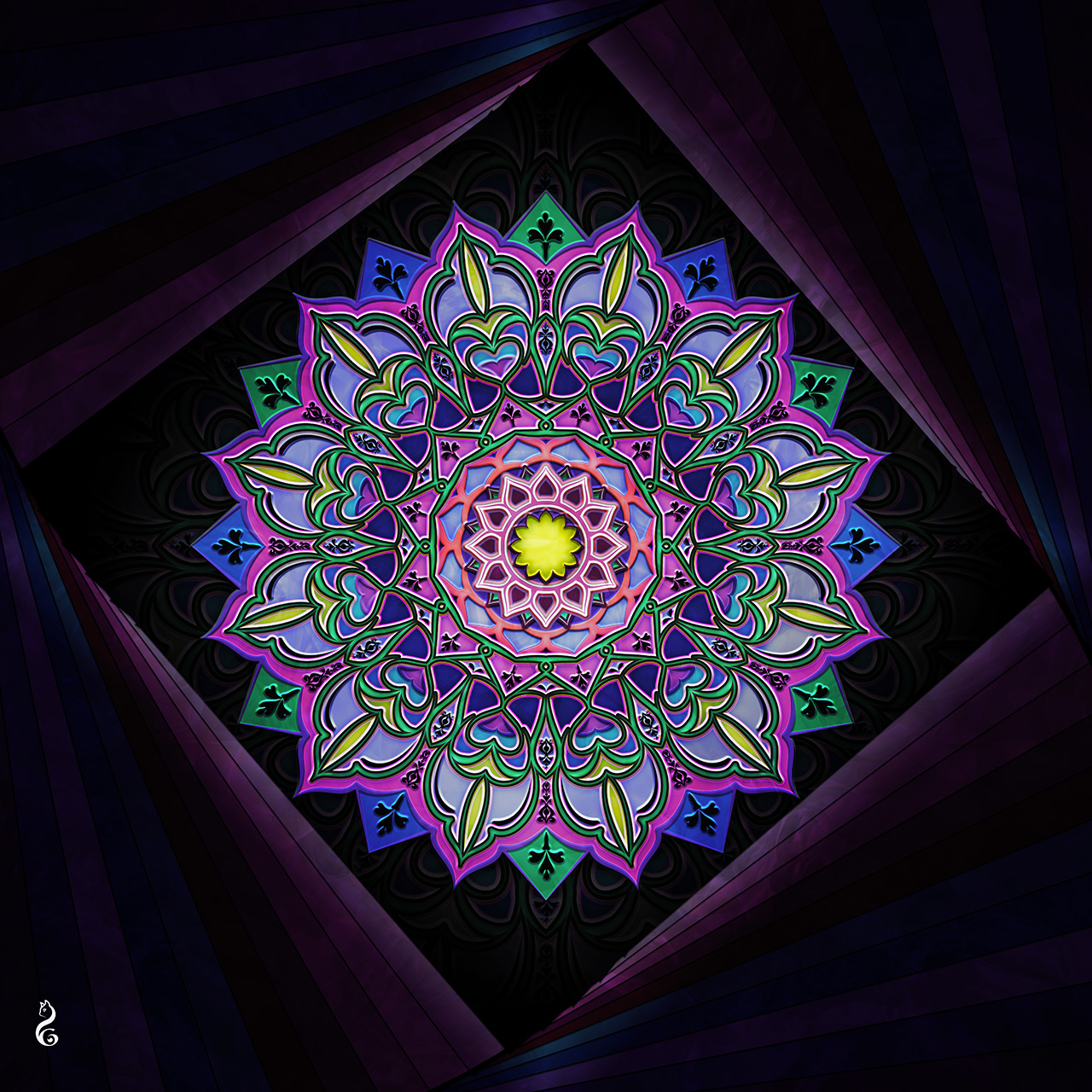60×60 cm. Print on canvas.
The theme of this Mandala, ‘Deliverance’ can be interpreted either in the horizontal-existential dimension or in the vertical-spiritual dimension, where the dimensions are not necessarily mutually exclusive.
By definition, “Deliverance” implies the abolition of constricting constraints, and the attainment of a state of independence.
In the first case, it concerns the resolving of certain psychic knots; in the second, that of the entire psychic and individual order, in that state that Hindus call “Moksa” and Buddhists “Nirvana”.
In this work by Giada Zammitti, the two dimensions merge into a seamless organic unity, creating a universal model in which everyone can find, in the form of a symbol, elements of their own mind.
Graphically, the pattern, a square that includes the central circular motif, synthesises the total Cosmos-Mind.
The sunny yellow centre expands in a play of psychedelic geometric possibilities, concluding in a dialectic of triangles, and half lotus flowers; both symbols of perfection and harmony.
Chromatically, from the explosion of solar yellow, all the colours of the so-called perceptible spectrum develop.
The combination of lines and colours gives the observer a penetrating and powerful synthesis of the theme: Deliverance
The Mandala offers itself to the viewer as an aesthetic delight but also as a theme for meditation.
WHAT IS A MANDALA
A mandala is a sacred geometric design that originated in ancient religious and spiritual traditions. It is often depicted as a circle with intricate patterns and symbols radiating from the center. The word “mandala” comes from the Sanskrit word for “circle,” and it represents the universe or the sacred space within it.
Mandalas are used as tools for meditation, spiritual reflection, and personal growth. They are believed to help individuals connect with their inner selves, find balance and harmony, and tap into a higher state of consciousness.
The design of a mandala is highly symbolic. The circular shape represents wholeness and unity, reminding us of the interconnectedness of all things. The center of the mandala is considered the focal point, representing the center of our being or the divine essence within us.
Creating or engaging with mandalas can be a transformative practice, offering a pathway to inner peace, self-discovery, and spiritual growth.
60×60 cm. Print on canvas.
The theme of this Mandala, ‘Deliverance’ can be interpreted either in the horizontal-existential dimension or in the vertical-spiritual dimension, where the dimensions are not necessarily mutually exclusive.
By definition, “Deliverance” implies the abolition of constricting constraints, and the attainment of a state of independence.
In the first case, it concerns the resolving of certain psychic knots; in the second, that of the entire psychic and individual order, in that state that Hindus call “Moksa” and Buddhists “Nirvana”.
In this work by Giada Zammitti, the two dimensions merge into a seamless organic unity, creating a universal model in which everyone can find, in the form of a symbol, elements of their own mind.
Graphically, the pattern, a square that includes the central circular motif, synthesises the total Cosmos-Mind.
The sunny yellow centre expands in a play of psychedelic geometric possibilities, concluding in a dialectic of triangles, and half lotus flowers; both symbols of perfection and harmony.
Chromatically, from the explosion of solar yellow, all the colours of the so-called perceptible spectrum develop.
The combination of lines and colours gives the observer a penetrating and powerful synthesis of the theme: Deliverance
The Mandala offers itself to the viewer as an aesthetic delight but also as a theme for meditation.
WHAT IS A MANDALA
A mandala is a sacred geometric design that originated in ancient religious and spiritual traditions. It is often depicted as a circle with intricate patterns and symbols radiating from the center. The word “mandala” comes from the Sanskrit word for “circle,” and it represents the universe or the sacred space within it.
Mandalas are used as tools for meditation, spiritual reflection, and personal growth. They are believed to help individuals connect with their inner selves, find balance and harmony, and tap into a higher state of consciousness.
The design of a mandala is highly symbolic. The circular shape represents wholeness and unity, reminding us of the interconnectedness of all things. The center of the mandala is considered the focal point, representing the center of our being or the divine essence within us.
Creating or engaging with mandalas can be a transformative practice, offering a pathway to inner peace, self-discovery, and spiritual growth.







